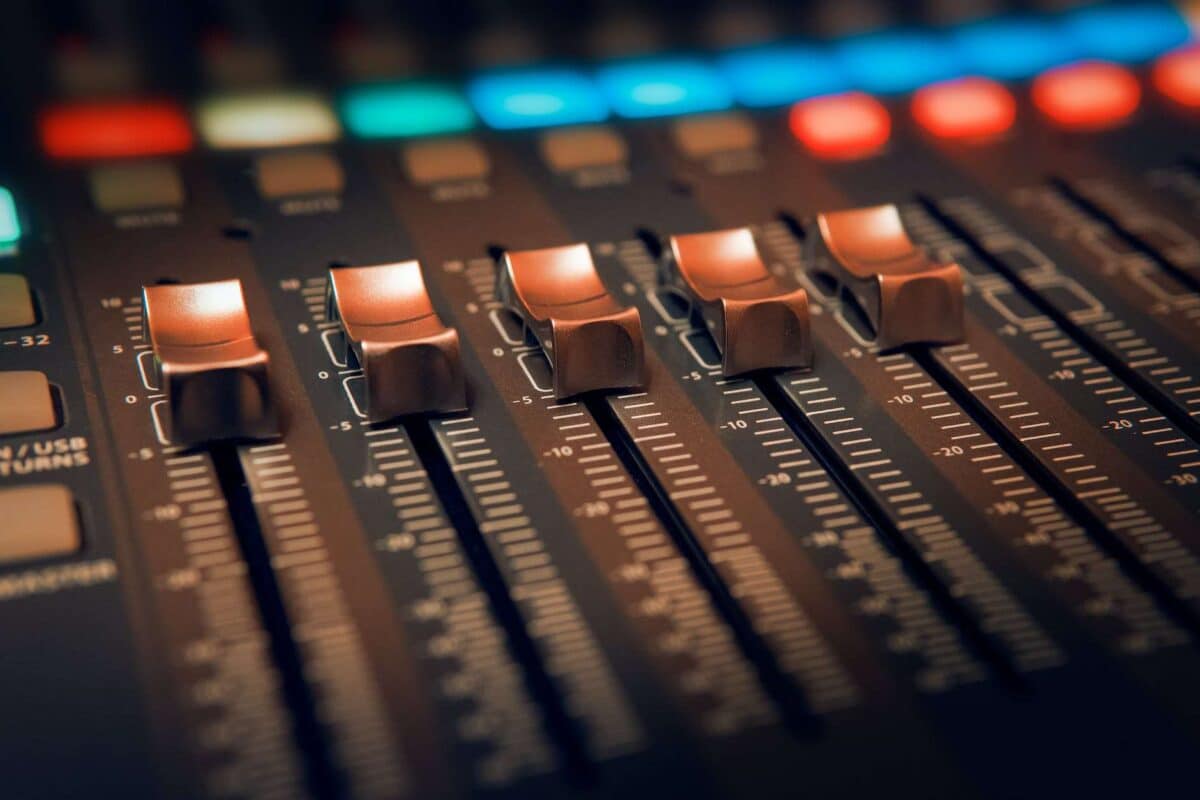Audio mixing is a nuanced, technical, and artistic process involving collecting raw tracks and transforming them into a cohesive and polished final product. This is where artistry intersects with technical expertise. For upcoming musicians and producers, mastering this art is essential to ensure their music achieves the desired emotional impact and clarity. This post will explore key techniques and tips for effective audio mixing.
Audio Mixing combines multiple tracks within a recording to create a single stereo audio file. Elements like levels, panning, EQ, and effects (like reverb and delay) are adjusted and balanced during mixing. The mixer’s role is to ensure that all parts are heard, interact well with each other, and that the overall sound matches the desired artistic vision.
Understanding the Basics of Audio Mixing Audio mixing is about fusing multiple recorded tracks, adjusting and amalgamating them based on their output levels, frequency content, dynamic range, and spatial distribution (panning) to create a well-rounded, solid sound.
Key Components of Mixing
- Level Balancing: Adjust the volume of each track so that no instrument is too loud or soft compared to others.
- Equalization (EQ): Fine-tune frequencies for clear sounds and prevent frequency clashes.
- Panning: Position sounds in the stereo field to create a sense of space.
- Dynamics Processing: Use tools like compressors and limiters to manage the amplitude range.
- Effects and Processing: Use reverb, delay, and other effects to create a better ambiance and depth.
Techniques and Considerations for Effective Mixing
- Start with High-Quality Recordings: Ensure your initial recordings are clean and high quality. Pay attention to room acoustics to avoid unwanted reverb or echo.
- Create a Balanced Mix with Level Adjustments: Begin by balancing the volume of each track to ensure a harmonious mix. Use professionally mixed tracks as reference points.
- Use EQ for Clarity: Prefer cutting frequencies over boosting to avoid distortion. Be mindful of the frequency range of each instrument to avoid overlaps.
- Apply Panning for a Spacious Sound: Use panning to create a sense of space and help separate instruments while maintaining a balanced sound.
- Dynamics Control for Consistency: Utilize compression to level out the dynamic range and make the mix more consistent. Apply limiting carefully to avoid clipping while preserving performance dynamics.
- Add Depth with Reverb and Delay: Use reverb to add space, depth, and delay for creative effects or to enrich sounds.
- Monitor Levels and Check on Different Systems: Mix at moderate levels to avoid ear fatigue and regularly check your mix on different systems like headphones and car stereos for good translation.
- Take Breaks and Seek Feedback: Regular breaks help maintain objectivity and reduce ear fatigue. Share your mix with others for different perspectives.
- Continuous Learning and Experimentation: Keep up with new mixing techniques and software trends. Don’t hesitate to experiment with different effects and settings, as breaking the rules can lead to unique sounds.
Choosing the Right DAW for Mixing
Selecting the right DAW is crucial for an efficient mixing workflow. Here are some popular DAWs known for their mixing capabilities:
- Pro Tools: Widely used in the professional audio industry, Pro Tools offers comprehensive mixing tools and exceptional compatibility with hardware.
- Logic Pro X: Known for its user-friendly interface, Logic Pro X provides a vast array of plugins and virtual instruments, making it a favorite among musicians.
- Ableton Live: Perfect for electronic music producers, Ableton Live offers real-time performance and mixing capabilities.
- Cubase: Renowned for its MIDI capabilities and advanced mixing features, Cubase is a favorite among composers and arrangers.
- FL Studio: Ideal for beginners, FL Studio offers an intuitive interface and a wide range of stock plugins.
Essential Mixing Plugins
To enhance your mixing process, you’ll need a set of plugins. Here are some essential ones to consider:
- EQ Plugins: Waves SSL E-Channel, FabFilter Pro-Q, and Universal Audio API 550A.
- Compressor Plugins: Universal Audio LA-2A, Waves SSL G-Master Buss Compressor, and FabFilter Pro-C.
- Reverb Plugins: Valhalla VintageVerb, Eventide Blackhole, and Lexicon PCM Native Reverb Bundle.
- Delay Plugins: Soundtoys EchoBoy, UVI Relayer, and Waves H-Delay.
- Saturation Plugins: Universal Audio Studer A800, Soundtoys Decapitator, and Waves J37 Tape.
- Virtual Instruments: Native Instruments Kontakt, Spectrasonics Omnisphere, and Arturia V Collection.
Remember that the choice of DAW and plugins often comes down to personal preference and the genre of music you produce. Experimentation and finding what works best for your style are essential.
Learning the art of mixing can greatly enhance the quality of your music productions. Here are some places where you can acquire knowledge and skills in audio mixing:
- Online Courses and Tutorials: Websites like Udemy, Coursera, and LinkedIn Learning offer a wide range of online courses on mixing and audio production. YouTube hosts numerous tutorial channels dedicated to mixing techniques. Channels like “Produce Like A Pro” and “Recording Revolution” provide valuable insights and tutorials.
- Digital Audio Workstation (DAW) Documentation: Most DAWs come with comprehensive user manuals and documentation explaining their features and providing mixing guidance. Check the official website of your chosen DAW for resources.
- Books: Several books cover the principles of mixing in depth. “Mixing Secrets for the Small Studio” by Mike Senior and “The Mixing Engineer’s Handbook” by Bobby Owsinski are highly recommended.
- Online Forums and Communities: Joining online communities like Gearslutz, Sound on Sound, and Reddit’s r/audioengineering can be a great way to ask questions, share experiences, and learn from experienced mix engineers.
- Music Production Schools and Workshops: Many music production schools offer mixing and audio engineering courses. These can be more structured and provide hands-on experience with professional equipment.
- Podcasts: There are podcasts dedicated to audio production and mixing, such as “The Mastering Show” and “Recording Studio Rockstars,” where industry professionals share their knowledge and experiences.
- Online Mixing Challenges: Some websites and forums host mixing challenges where you can practice your mixing skills on real tracks and receive peer feedback.
- Mentorship and Collaboration: Collaborating with more experienced musicians and engineers can be an excellent learning method. Consider finding a mentor or working with others on mixing projects.
- Online Courses and Certifications: Some institutions and organizations offer online courses and certifications in audio engineering and mixing. Look for accredited programs to gain more formal recognition.
- Practice, Practice, Practice: Ultimately, the best way to learn mixing is through hands-on experience. Practice mixing your own songs or tracks from various genres to improve your skills.
Remember that mixing is both a technical and creative process, so balancing your theoretical knowledge with practical application is important. Continuously experimenting with different techniques and learning from your experiences is key to becoming a proficient mix engineer.
Audio mixing is a blend of science and art. While technical skills are crucial, developing a keen ear and a creative approach is equally important. Each mix is a new adventure, and your skills will continue to evolve with practice, patience, and passion.
Remember, the goal of mixing is not just to balance sounds but to effectively convey the emotion and message of the music. Whether striving for that polished radio-ready sound or aiming to capture the essence of your unique musical style, professional mixing services can make all the difference.
Author Bio:
Simon – With a deep appreciation for both the technical and creative aspects of music production, mixing and mastering, I share my knowledge and experiences with fellow musicians and aspiring artists through my website at songmixmaster.com.



